
Epic rock chimneys wobbling up out of the vast, serenity await you at the ends of the earth. We’re talking about the titular “torres” at Chile’s famed Torres del Paine National Park—a 700 square mile fragment of the epically-known Patagonia region, which expands across the southern tips of both Chile and its neighbor Argentina.
This region is also known as “Magellan’s Region” for the famed Portuguese explorer, Ferdinand Magellan, who stumbled across this breathtaking terrain in 1520.
But the torres (Spanish for “towers”) are not all the vastness of the park has to offer. The region features landscapes only otherwise accessible in photos; it is truly unique in its grandeur. And when you embark on your MORE Adventures W Circuit adventure, you’ll find yourself amidst the most serene, yet intimidating, expanses of natural beauty known to man.
What exactly does that mean?
The W Circuit is one of three major treks through Torres del Paine National Park, the most famous and followed, at that. The trail is named for its shape: we’ll traverse in zig zags to cover up to 80 kilometers (or 50 miles), hitting vista hot spots including the lake Nordenskjöld, Almirante Nieto Mountain, French Valley, Grey Glacier, and, of course, famous torres for which the park is named. The W Circuit truly is an epic, once-in-a-lifetime-type adventure!
A word of caution: the W Circuit is not an easy hike (nor are the other Torres del Paine hiking routes). Moreover, there are no towns in between stops. We’ll be sleeping at campsites or refuges (hostel-style stays that allow you to backpack sans sleeping and cooking gear), often eating camp-style meals, and no, there will not always be outlets next to your bed to charge your phone each night (consider a long-life portable charger). You’ll be exposed to a variety of (strong) elements; you’ll need to pack for most seasons and temps, and be able to carry all that entails in your own rucksack that you’ll hike with every day. Also, there will be very limited opportunities to wash your clothes.
With that in mind, before you eagerly pack your bags and arrive at the airport six hours early, there are a few important details you’ll need to heed in order to get the most out of this truly amazing adventure.
Traveling to Torres del Paine
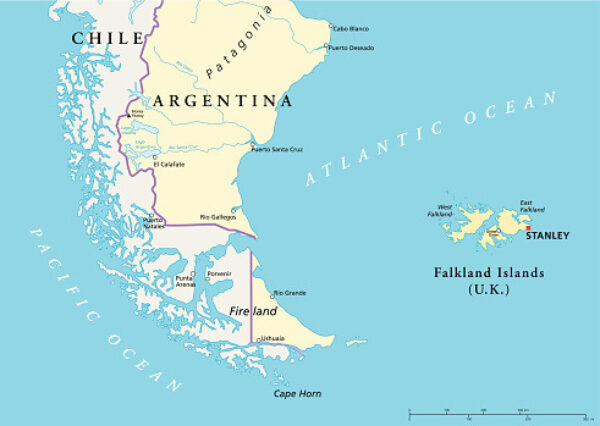
Map of Chilean Patagonia
Here’s a hint: it’s not as simple as walking off the plane at Comodoro Arturo Merino Benítez International Airport (Santiago Airport works, too).
Before you’re attempting to capture the magnificent beauty of Torres del Paine through your camera, here’s what you need to know to begin your trip to Chile.
Passports
Travel to Chile requires a passport from your country of nationality, valid for at least 6 months after your return.
Post Santiago Transpo
For reference, Santiago—Chile’s capital—lies just north of the country’s midway point (Chile is 2,653 miles long!), whereas the torres lie at its Southernmost region at the ends of the earth. MORE Adventures will meet you in Santiago and escort you on the 3.5 hour flight from the capital to Punta Arenas, the closest city to the park (and really, the only “city” in the region). After a short stopover there, we’ll all ride to Puerto Natales, the jumping off point to the park.
For the most part, you need only worry about getting to Santiago, but we thought you should know the journey doesn’t end there.
U.S. Embassy
There is a U.S. embassy in Santiago. Additionally, you can find further information for U.S. travelers (in case of emergency) here.
COVID-19
Chile will no longer be checking your COVID status!
Health & Safety
First and foremost, it should be noted that the U.S. has assigned a Level 2 travel alert for Chile right now due to civil unrest. This should not affect you at Torres (where there are few towns for miles and most of the people you’ll encounter are either tourists or associated with the park), however it’s good to know for when you arrive to Santiago, especially if you’’ll arrive more than a day or two before we depart for Punta Arenas and Natales.
As for health concerns, you should be A-Ok in the park, overall. The natural glacier water is mostly safe to drink (and probably some of the purest water you’ll ever drink, at that!). However, it would still be a smart move to bring a filtered water bottle or some other form of water filter.
Plan to pack at least bug repellant if not a mosquito net, however overnight temps are likely to be too low for the pesky bloodsuckers to bug you (pun intended) too much.
You should, however, ensure you are vaccinated against (among the regular ones you needed to go to school): COVID (see above), Hep A and B, as well as Typhoid.
For in-the-parks safety, you’ll absolutely need a headlamp to allow you to safely stumble around at night along with lots and lots of warm layers.
Finally bring either a universal outlet adaptor or an adaptor to outlet types C and L…preferably with a surge protector!
Money

Chilean pesos
Plan to convert or withdraw cash in Chilean Pesos (CLP), which currently run about 100 to every $0.12.
While credit cards are often accepted in major cities, the machines that read them are not totally ubiquitous across the country. And although ATMs run a-plenty in town, they’re all but nonexistent outside of town and near the national park, itself.
Interacting with Locals
Chileans are often quite friendly; as a culture, they’re affectionate. Moreover, they tend to air on the side of much more formal than U.S. Americans. Always address the most senior or head (of household) member in a group, first. Always use titles (Señor, Señora) unless someone has told you you may call them by their first name. Maintain eye contact throughout conversations.
When being greeted, you may receive a handshake, or a kiss on the right cheek. Reciprocate accordingly. You may also find that Chileans maintain a relatively close stance when talking to you (even post greeting). Do not back away; standards of personal space are much closer here, and balking at this can be seen as rude.
Additionally, do not click or snap your fingers at others, do not beckon someone over with your index finger, do not flick yours or someone else’s chin with your finger, and do not, under any circumstances, hit your left palm with your right fist (actually, avoid hand gestures in general). This is regarded as a highly vulgar gesture.
If you plan to stick around any city or town in Chile beyond our adventure, ensure you’ve packed non-hiking clothes. Chileans do not go out in public in athleisure or sweats, even for a quick run to the grocery store. Presentation matters. Women should not show bare legs in dresses, and as a general rule everyone should avoid overtly “sexy” clothing.
Much of Chile pays homage to the country’s mixed European cultural roots, and European standards reign in everything from dress to dining (Chileans follow European table etiquette and table manners). When dining out, you may have to ask for water, and you will most definitely have to ask for the check at the end of the night (hey, no rush!). Keep your hands visible and on the table at all times (never in your lap), and if you’re dining with someone, whoever invited pays the whole bill (no splitting the check, here). A 10% service charge is often auto-added to your bill, but leaving an additional 5-10% beyond that is standard. Also, as a note, dinner is served at 8 P.M. at the earliest—and even then you may be the only party in a restaurant—so plan for that.
Finally, when talking with locals, avoid discussion of politics and human rights at all costs. Do not compare the U.S. (or anywhere else) to Chile. Make sure you show genuine interest in conversations with locals. If you smoke, you must offer cigarettes to all parties. Finally, Chilean men will stare at women. The word is “deal”; culturally this is still completely accepted and normal.
At Torres del Paine National Park: Dos and Don’ts
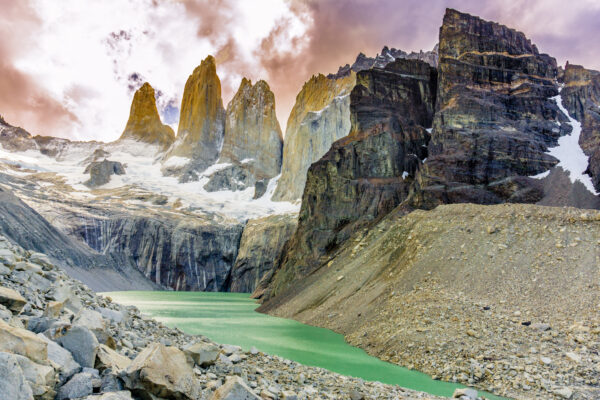
Glacial Torres del Paine
Forget everything we’ve just told you (well, not completely). If European standards take the cake in the capital and Northern half of Chile, the wilderness absolutely dominates the Patagonia region. Sure etiquette is etiquette, but things work a little differently in the wild.
Nature
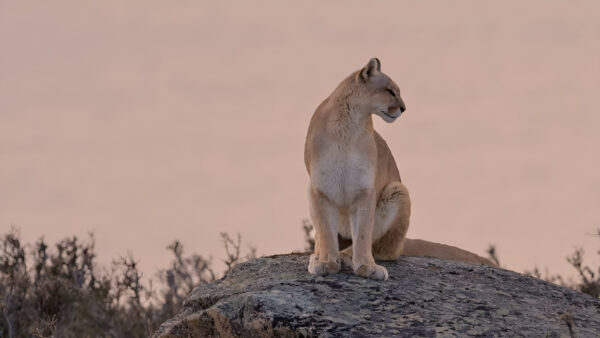
Patagonian Mountain Lion
Torres del Paine is a natural splendor truly unlike any other.
It only stays that way through strict adherence to the paramount rule when visiting a national park— leave no trace.
Even at one of the southernmost points of the entire world, the torres see roughly a quarter of a million visitors per year! And it is absolutely crucial that each and every one of those visitors do everything in their power to minimize their footprint in the parks.
That means no littering. That means sticking to the marked path. That means, and especially so, no fires.
You must be prepared to carry absolutely everything (and we do mean everything) that you bring to, or produce in, the parks at least to the nearest trash can (which you might not find until the end of the day).
Applying to any scenario from accidentally crushing the lush and varied vegetation beyond the actual trail of the W circuit all the way to litter, such as burrito wrappers and toilet paper squares, your ultimate goal should be to leave the park exactly as you found it.
Part of the park’s splendor is its pristine nature. Maintaining that pristine nature is essential, and it’s an effort that’s been in the works for literal centuries.
Safety
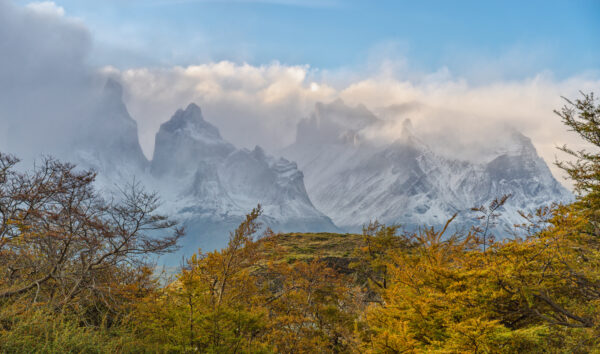
Torres del Paine through the fog
The W Circuit is a 6-day hike through something akin to a cold desert. Even though we’re traveling in the Chilean late spring, the highs will likely cap in the high forties, while the lows may hit just below freezing. You’ll need layers—warm layers.
Additionally, you’ll need to be a skilled hiker. This trip is definitely not a beginner-level trek; unless you look at this from a reverse hemisphere perspective where our beginner is their advanced.
For your own safety, please seriously assess your hiking abilities and consider selecting another adventure if you’re unsure.
Animals
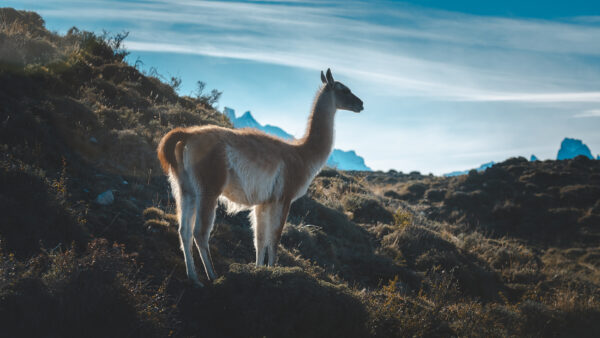
Guanaco, cousin to the llama, alpaca, and vicuña
Impressive flora and fauna are a staple across the Torres del Paine National Park. If we all play it cool, calm, and collected, we might just get to see…
- Grey and red foxes
- Guanacos (llama relative)
- Dwarf armadillos
- Patagonian skunks
- Condors
- Huemuls (south Andean deer)
- Pumas/mountain lions
Oh, my!
Packing
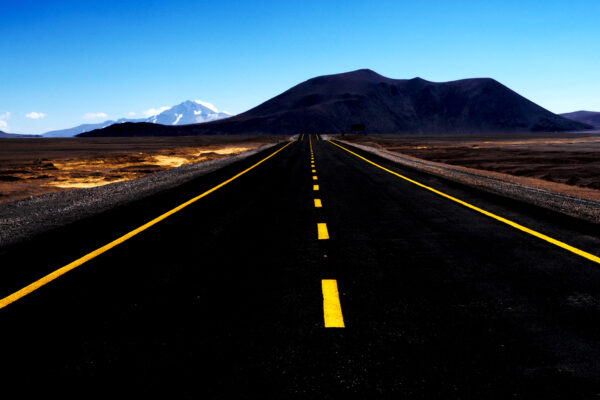
All roads to Patagonia and the Atacama Desert
Pack for all weather, seriously. Do some research on the park’s average weather during your month of travel, and then expand your packing selection out about 20 degrees on both ends. You will be exposed to a variety of elements, all of which will be magnified (be that good or bad) by the vastness of the park.
You’ll also be outside, being active, all day long. Layers will be essential.
Here’s some more concrete recommendations:
- Lightweight backpack
- Short and long sleeved tops (combo is key)
- Fleece
- Waterproof jacket and other gear
- Down jacket
- Zip off pants
- Leggings (be prepared to layer bottoms, too)
- Scarf
- Headband
- Warm hat
- Microfibre travel towel
- Dry bag
- Gloves
- Liner socks
- Wool socks
- Compression socks
- Regular socks
- Long/thermal underwear
- Swimsuit (hot springs)
- Quality hiking shoes (break these in early!)
- Hiking poles
- Hiking grade sandals
- Power bank with cable
- Adaptor for electronics
- Swiss army knife
- Headlamp
- Camera
- Lo-fi activities for after dark
- Camera
- Water filter
- Water bottle
- Sunglasses
- Sunscreen
That ought to do it…or at least get you started.
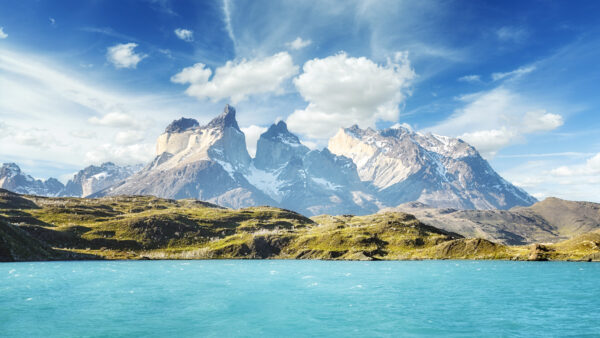
Pehoe Lake and Los Cuernos (the Horns) in the Torres del Paine National Park, Chile.
Preparation is key for anything, and never is that more true than on your unique, MORE Adventures Torres del Paine W Circuit Adventure! That said, the most important measure you can take is to be flexible, above all. Current conditions change, the weather changes, plans change, travel arrangements change. The more you can go with the flow, the more you’ll get out of this bucket list experience!
MORE Adventures is dedicated to bringing travelers not just another group trip, but a trip that pushes them outside of their comfort zones and challenges their world perspective. We are determined to bring you life-changing experiences that don’t just allow you to relax, but rather equip you with the tools you need to handle the day-to-day when things get tough. Our holistic approach to nature and adventure will leave you with a stunning new outlook on life.

